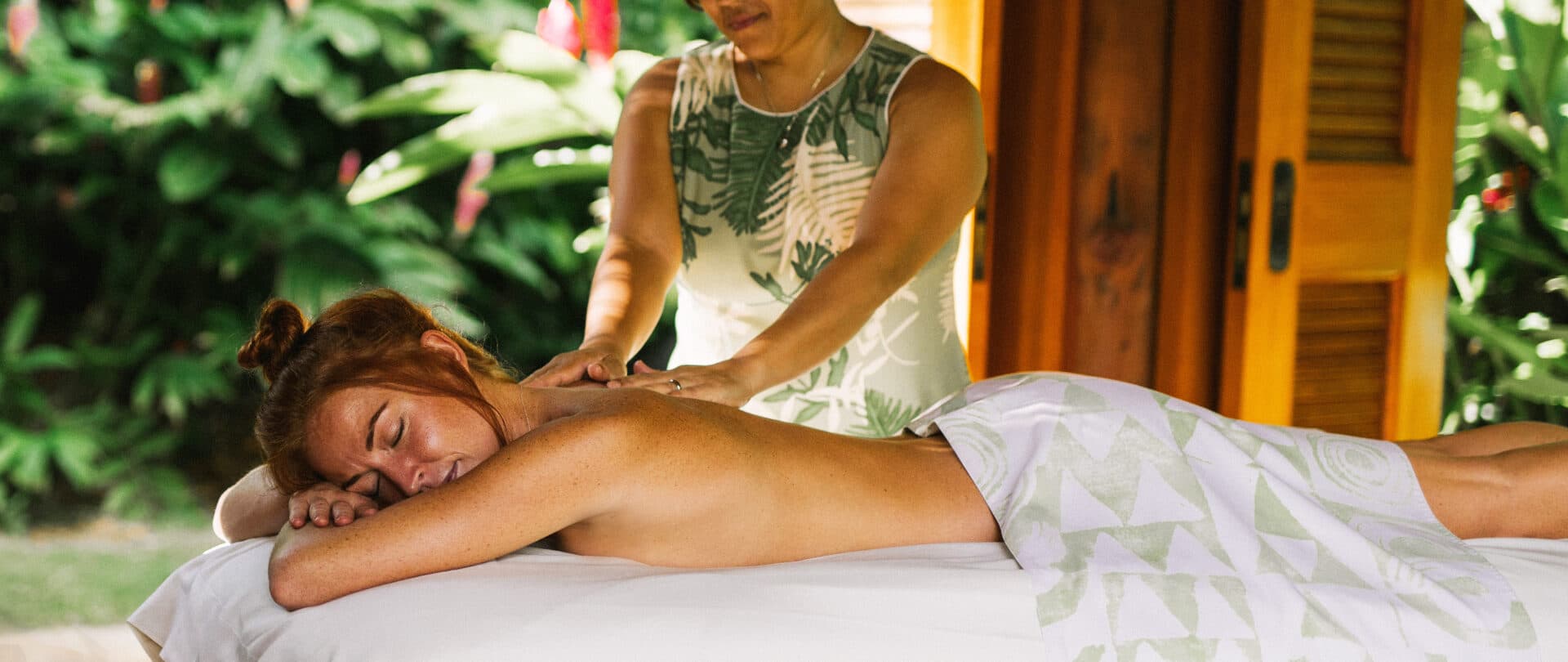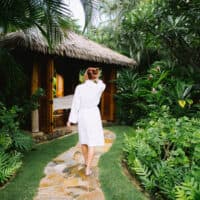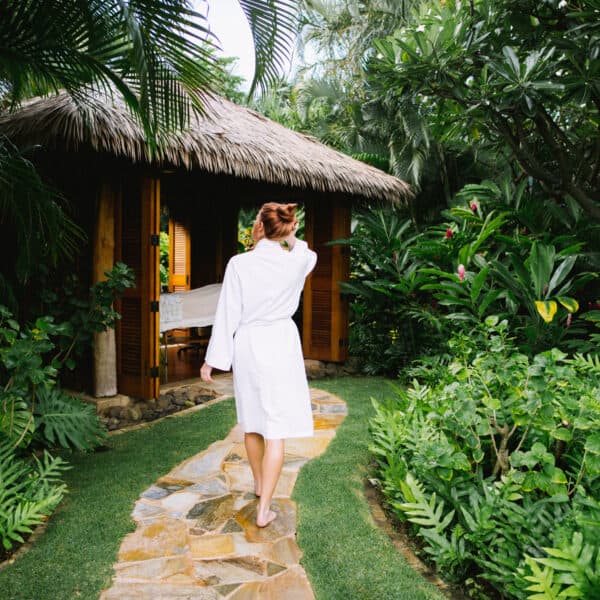
Restorative Plants
The vital role of canoe plants in beauty treatments and healing therapy.
BY Krystal Kakimoto
Kaua‘i is the oldest island of the main Hawaiian islands and known the world over for its breathtaking beauty and awe-inspiring views. Thousands of visitors flock to the island annually for a chance to relax amongst the emerald valleys and tropical rainforests that make up the island. Yet, the healing components of the island are far more than just surface level. Kaua‘i is also home to a bounty of native plants and botanicals that hold the power to repair bodies and rejuvenate senses.
When the first Polynesian voyagers set sail to the islands we now know as Hawai‘i, they brought with them plants and knowledge from their homeland necessary to establish communities wherever they landed. Along with knowledge of agriculture, aquaculture, weather and star navigation, these voyagers also brought their knowledge of healing and restorative plants. Today, the 24 different varieties of plants the voyagers loaded to their outrigger canoes are known as canoe plants. The plants were selected for their ability to support all aspects of life— from plants grown to nourish the body as food sources to others that were used to mend and restore the body.
One highly prized canoe plant that plays a vital role in healing therapies and beauty treatments comes from the rich and viscous oil produced from the nuts of the kukui (candelnut) tree, Hawai‘i’s state tree. When broken apart, the hard-shelled nuts expose a soft-centered flesh whose oils are rich in vitamins A, E, C, and antioxidants. The high levels of linoleic fatty acid found in kukui nut oil are known to coat hair and create a protective barrier that locks in moisture. This same oil also plays a significant role in lā‘au lapa‘au, the holistic Native Hawaiian approach to healing the mind, body, and spirit. Within this tradition, kukui nut oil is used to treat myriad skin ailments since it is a non-irritating oil and can be used not only as a daily skin moisturizer but even to reduce the symptoms of certain skin conditions such as eczema.

Another important canoe plant that Polynesian voyagers brought with them was ‘awapuhi kuahiwi, also known as shampoo ginger or wild ginger. The plant agreed with Hawai‘i’s climate and now thrives wild in the Hawaiian rainforest where its pinecone-like flowers, which range from greenish-red hues to a vibrant crimson, decorate the lush wilds. When pressure is applied to these flowers, a slimy, sudsy liquid is produced, a gently scented blend of exotic florals and summery freshness. In lā‘au lapa‘au traditions, this liquid was used as a compress for sores, cuts, or bruises and prized as a valuable body cleanser. The aromatic liquid would be extracted from the flowers and applied directly to the hair. With a gentle massage-like motion, the ‘awapuhi liquid emulsifies, becoming a delightful shampoo that softens the hair while leaving tresses shiny and smooth.
Although not one of the original canoe plants, ‘aloe (aloe vera) is known to locals as a secret weapon against sunburns and skin damage. This short-stemmed shrub originated in the Arabian Peninsula yet does surprisingly well in Hawai‘i’s tropical environment and is now found everywhere from mountain hiking trails to the suburban backyards. Locals will keep a shrub or two of this plant in their gardens and apply liberal amounts of the gel-like flesh to sunburnt skin, capitalizing on the plant’s natural cooling and anti-inflammatory properties. Full of vitamins C and E, and beta-carotene, ‘aloe can also be a part of daily skin routines keeping skin hydrated and clear.
When blemishes do appear on the skin, one traditional remedy is the application of clay to dry out the skin and absorb impurities. Used since the dawn of civilization, clay applied to the skin can ward off bugs from landing on the skin and even serve as a layer of protection from the sun. Mālie Organics, a company headquartered on Kaua‘i, harnesses the detoxifying characteristics of clay in their Kaua‘i Clay Mask. Infused with noni (Indian mulberry), a canoe plant applied to heal wounds and clear up facial blemishes, and the sap of the ‘awapuhi ginger, the mask deeply cleans pores and brightens the complexation.
Mālie products pull inspiration from the paradise of the islands and infuse traditionally used botanicals with the power of science. One product highlighting the power of canoe plants is their Kōke‘e Conditioner that transports users to the lush forests of Kōke‘e with its fresh scent mimicking the crisp mountain air scented with local foliage. The Kōke‘e Conditioner blends macadamia nut oil to increase the hair’s shine and health by strengthening hair follicles to reduce hair loss with kukui nut oil, whose essential fatty acids moisturize hair from the inside out. Never tested on animals, this conditioner works its magic in under three minutes, leaving hair restored and rejuvenated even after a long day in the sun.
On the island of Kaua‘i, the Anara Spa aims to blend the nurturing and restorative approach of Hawaiian healing practices with the bountiful botanical products found on the island. Within their 45,000-square-foot spa, their team of trained estheticians and treatment practitioners offers an integrated approach to a day of relaxation. Along with utilizing the Mālie line of products in their spa experiences, the Anara Spa also presents guests with opportunities to experience traditional Hawaiian healing practices.
In Hawaiian, the word lomi translates to “to knead, to rub, and to soothe;” and when stated twice, there is an added emphasis to the meaning. The flowing strokes and soothing pressure of a lomilomi massage aim to release the tension from the back, legs, shoulders, and arms by the practitioner administering massage by applying pressure with their palms, forearms, fingers, knuckles, and even elbows. The differences between the lomilomi style varied from family to family and even ahupua‘a (a land division usually extending from uplands to sea) to ahupua‘a. Lomilomi was often given between family members to restore strength or administered to ali‘i (chiefs) to heal and aid in digestion. Today, the Anara Spa offers its own lomilomi experience to ease tight muscles and reduce tension with the perfect balance of flowing strokes and supple pressure.
The spa also offers guests a chance to refresh their senses in the invigorating Kope Coffee Body Polish experience. The Kaua‘i-made body scrub blends exotic ginger and aromatic coffee and is applied to the body with deft strokes to stimulate circulation and remove dead skin cells. The coffee serves as a vasoconstrictor which tightens blood vessels leaving skin brightened, smooth, and less puffy which the diuretic aspects of the caffeine help reduce water retention and the appearance of cellulite on the skin.
Whether you are looking to soothe sunburnt skin, reduce fine lines or wrinkles, or relax stiff muscles and alleviate your stress, the island of Kaua‘i will serve as the perfect backdrop for your time of rest and rejuvenation. By blending the native healing techniques with the bountiful botanicals the island has to offer, you can experience the healing aspects the island has to offer from both the inside and out.
You May Like
Features

See + Do



